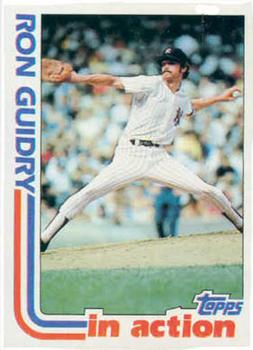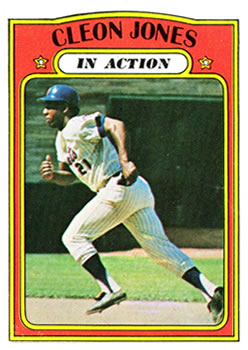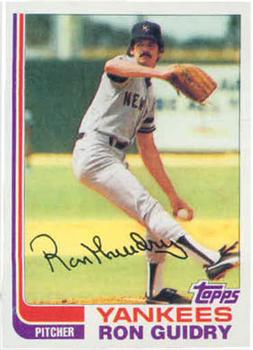Who Can It Be Now?
It's still Ron Guidry, just like Card #9. Ten years after the concept debuted in 1972, Topps brought back the "In Action" subset. In 1972, the idea was novel. Before that time, nearly every Topps card was a posed photo, though a few action shots did appear from time to time for World Series subsets.
Let's use the first "in action" card numerically from 1972 -- Cleon Jones -- to demonstrate:
Here's Cleon's base card:
Now, if Topps in 1982 had gone with a portrait for the base cards for guys appearing "in action," it would have been a reasonably cool subset. But, let me remind you of Guidry's base card:
In other words, this "In Action" shot adds nothing here.
Trivial Pursuit
Since we had the homespun Cajun Guidry story about his rabbit stew yesterday, let's today list some random facts about Guidry and his career:
- The infamous George Brett "Pine Tar" game started on July 24, 1983 and ended on August 18, 1983. Guidry played center field (and Don Mattingly played second base) for the final out in the top of the ninth inning on August 18. His spot in the order came up in the bottom of the ninth, but Billy Martin sent Oscar Gamble up to hit for Guidry instead.
- The Pine Tar Game was the second time that Martin had inserted Guidry into center field for an inning. On September 28, 1979, in a meaningless game at the end of the season -- the Yankees were 14.5 games behind the Orioles and their opponents, the hapless expansion Blue Jays, were a whopping 50.5 game behind -- Martin put Guidry in for the ninth inning.
- Guidry did not get to make a putout or even field a chance in either game.
- As is the case for many teams, spring training is a time when the old-timers come out to the park and serve as "instructors" -- or at least interested observers. It's not rare. But, when one great player serves effectively as a chauffeur, it can make for a good book -- such as this one: Driving Mr. Yogi: Yogi Berra, Ron Guidry, and Baseball's Greatest Gift.
A Few Moments With Tony L.
While Guidry was generally an excellent pitcher and was a Yankee to the bone, I can honestly say that I did not hate him in 1982. This comes in large part from the fact that he did not pitch very well against the Brewers.
In those days before the Rockies and Marlins joined the National League, baseball employed what it called a "balanced" schedule. This meant that you played 13 games against the six teams in your division (78 games) and 12 games (84 total) against the seven teams in the other division. So, you were almost as likely to have a rivalry against a team in the other division -- and trust me, Brewers v. White Sox and Brewers v. Twins games sometimes had a real edge...perhaps as a carry over from the NFL rivalries, but that edge between the fans was real and palpable.
Getting back to Guidry, the fact was that the Brewers faced Guidry just 26 times (24 starts) in his career. This compares to the 25 times -- all starts -- that Guidry faced the Rangers and the 30 games -- again all starts -- that Guidry faced the Twins. In addition, Guidry's record against the Brewers was not great: 10-8, 3.54 ERA overall.
Add in the fact that Guidry pitched less in Milwaukee County Stadium than he did in any other stadium, and he pitched very poorly there: 1-3 record, 5.05 ERA. In 7 starts and 2 relief appearances, Guidry threw 46-1/3 innings and gave up 57 hits -- 7 homers -- and 26 earned runs.
Going back to yesterday's Hall of Fame discussion and looking at the park-specific statistics, it is pretty obvious that Guidry pitched to Yankee Stadium's dimensions -- with the huge outfield and deep power alley in left-center.
While I am not saying that Guidry was a one-trick pony, I think a review of his stats give the picture that his career is not all that different than the ones enjoyed by hitters like Dante Bichette in Colorado: you cannot leave out the fact that Guidry's home park was extremely favorable to him and, therefore, you can discount his career statistics to an extent. Add in the fact that he was never durable over his career -- which brought down his career numbers -- and you have a guy who was very, very good but not one of the all-time greats.





No comments:
Post a Comment